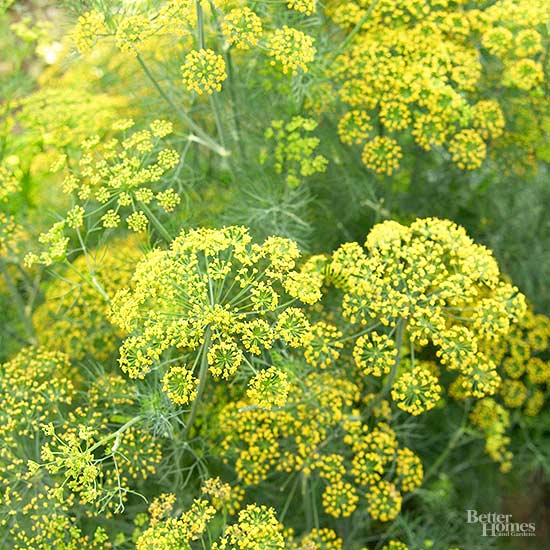






Dill is easy to start from seed and grows best when planted outdoors. Choose a location with full sun -- at least eight hours of direct sunlight per day -- and well-drained soil. If your soil holds water thanks to heavy clay, dig organic matter such as compost into the top few inches to help drainage.
Sow seeds directly into the soil, placing them ¼ inch deep and about 1 to inches apart in rows 6 inches apart. Depending on the variety, dill grows 1 to 3 feet tall, so thin (remove by pulling or cutting) the seedlings so they are 12 to 24 inches apart. It may seem cruel, but thinning allows each remaining plant to grow best.
To keep a continual source of fresh dill on hand, consider succession planting. Start by sowing just a few seeds from the packet at first, then a few more each week during the growing season.
You don't need to plant dill in rows. If you want dill plants to self sow, plant them in clumps where the seeds can drop and grow the following year.
Proper watering is essential for growing dill. Keep the soil evenly moist while seeds are germinating. Once dill plants start growing, they need about 1 to 2 inches of rain or additional water to thrive.
Most herbs, including dill, don't need additional fertilizer. But if you wish, you can apply a balanced 10-10-10 fertilizer once or twice during the growing season. Use a liquid fertilizer mixed with water or scratch a time-release fertilizer into the ground at planting time.
When temperatures rise, dill tends to "bolt" and send up flower stalks so it can set seeds. Once this annual herb flowers and sets seeds it dies, so you can keep the plant going for one growing season as long as you remove the flowers.
continue reading belowDill is not considered a weed, but some spice companies and people refer to the dill plant as dill weed, perhaps because of the feathery foliage. Dill weed is fresh or dried foliage. Dill seed is produced from the pretty yellow umbels of flowers.
Even if you don't have an outdoor garden, you can still keep pots of dill on a sunny balcony or deck. Choose a container at least 12 inches deep; dill plants grow with a deep taproot. Remember to keep the spacing of 12 to 24 inches in mind, depending on the width of the container.
Dill doesn't perform to its full capacity in an indoor herb garden, but it is worth starting a few seeds indoors to harvest as soon as the plants begin to form leaves. Succession planting in an herb garden is worth doing indoors, too.
Fresh dill weed begins to droop as soon as you clip it and begins losing potency within a couple of days. Use it as soon as possible. You can store fresh dill in the refrigerator with stems tucked into a container of water or with leaves wrapped in a damp paper towel. The bright flavor is great with potatoes, vegetables, fish, salads, soups, and stews.
Fresh dill flower umbels look beautiful in a mixed bouquet, but don't be surprised if the plants begin to wilt after a few hours. They're perfect for quick bouquets clipped just before a dinner party.
You can freeze fresh dill by placing it in water in ice cube trays. Drop the cubes into cooked dishes that can handle the additional moisture.
Although the flavor becomes muted, dill leaves and seeds are easily dried for later use. To dry the leaves, hang an entire plant upside down in a warm, dry location until you can strip off the foliage. Or, snip the leaves while fresh, place on a plate, and allow them to air dry.
To harvest dill seeds, cut the flower stalks after the yellow blooms have faded but just before the seeds begin to ripen and loosen from the umbel. Place a small paper bag with a few tiny holes for ventilation over the entire flower head, hang the plant upside down in a cool, dry location, and wait for the seeds to fall and gather in the bottom of the bag. Store the seeds in an airtight glass container in a cool, dry, dark place.
Consult pickle recipes for specific directions on making pickles and food safety. In general, add two to five clean, fresh dill seed heads to each batch. Dried dill can be used, but it may not provide as good a flavor.
Copyright © www.100flowers.win Botanic Garden All Rights Reserved